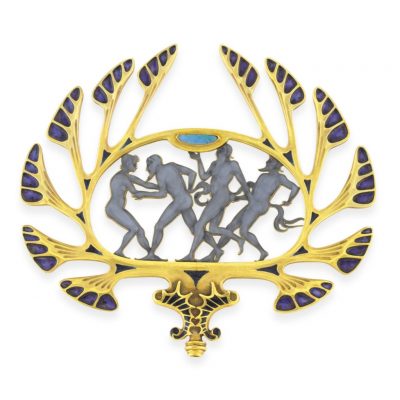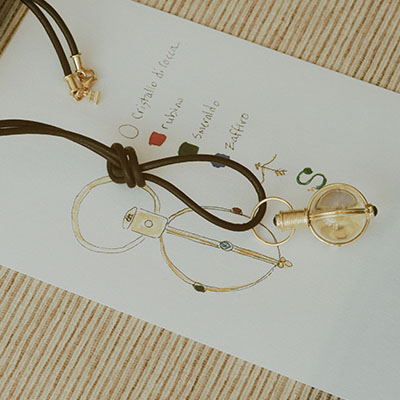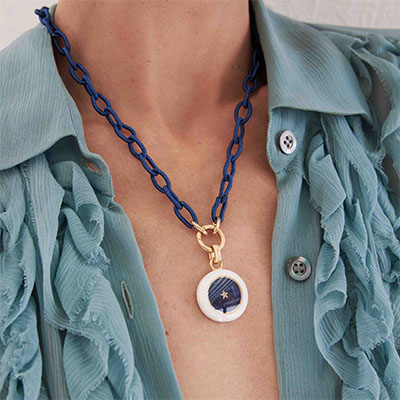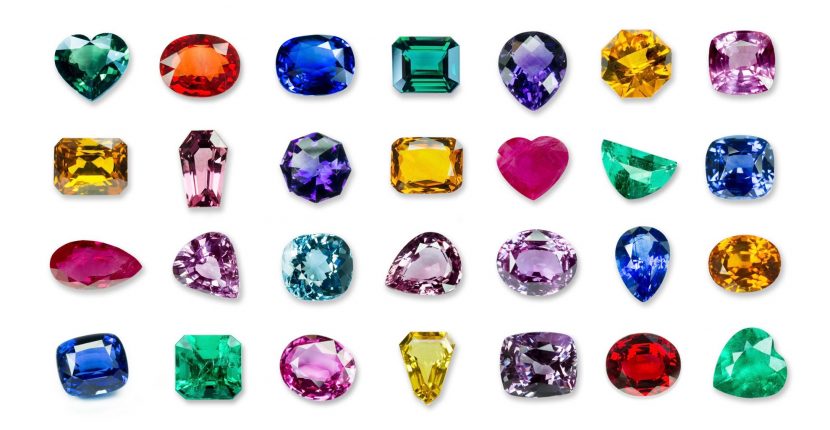
An array of colorful gems Photo iStock
Rocks My World
The Ultimate Guide to Birthstones
Everything you need to know
The tradition of birthstones has been around for so long you probably think the list of gems is, um, set in stone, right? Wrong. Despite the fact that the concept has roots going back to Biblical times, the list has been updated as recently as two years ago.
The essence of the modern American list was created in 1912 by the National Association of Jewelers, the group that is known today as Jeweler’s of America. It was an effort to organize the gems that had been associated with various months over the centuries. After that landmark moment you would think the list still would be complete, but no. In 2016 Jeweler’s of America added spinel to the month of August. JA President and CEO David Bonaparte told National Jeweler, “At certain moments in history, when there is a strong call from gem enthusiasts to expand the list of official birthstones, Jewelers of America believes in recognizing the importance of historically significant gemstones and giving gemstone lovers a choice that suits their preferences.” So, if you are not fond of your birthstone, consider beginning a campaign for a new one.
Among the numerous stories about the therapeutic influence of gemstones, it is generally agreed that wearing a gemstone during the month it is the birthstone heightens its healing powers. Read on to learn what else the gems are thought to do, a little about their histories, where they come from and other fun facts. Since there is no set way to wear birthstones most are illustrated with a historic jewel and a contemporary design as a way of showing a thread line through time of how a gem has been mounted in jewelry.
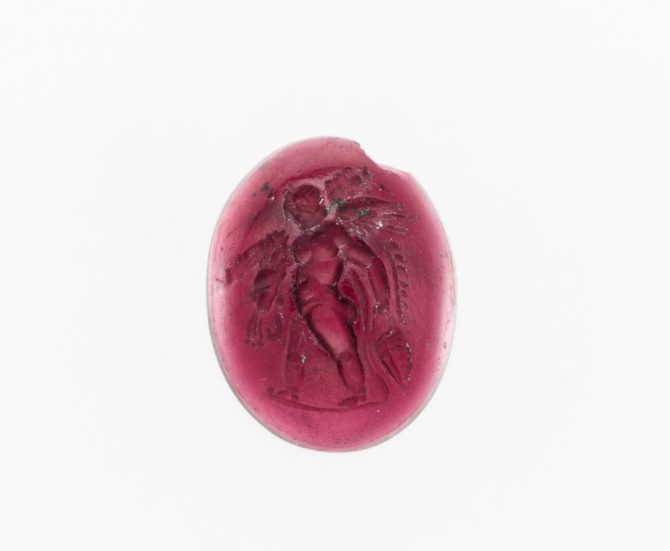
An almandine garnet intaglio dating from the Hellenistic period in Greece, around the 1st century BC features Eros walking and proudly carrying off the weapons of Herakles: the lion’s skin, club, bow, and the quiver. Photo The MET Museum
JANUARY
Birthstone: Garnet
What’s in a Name: Derived from the Latin word for seed, granatum, the seed in the case of garnet is the red shade of a pomegranate seed.
Some Places Where it’s Found: Czech Republic, Greece, Russian, Tanzania, Madagascar, Sri Lanka, and India
True Colors: While the most widely known color is the red of the Pyrope Garnet, the stone comes in lots of other shades including orange Mandarin Garnets and green Tsavorite Garnets.
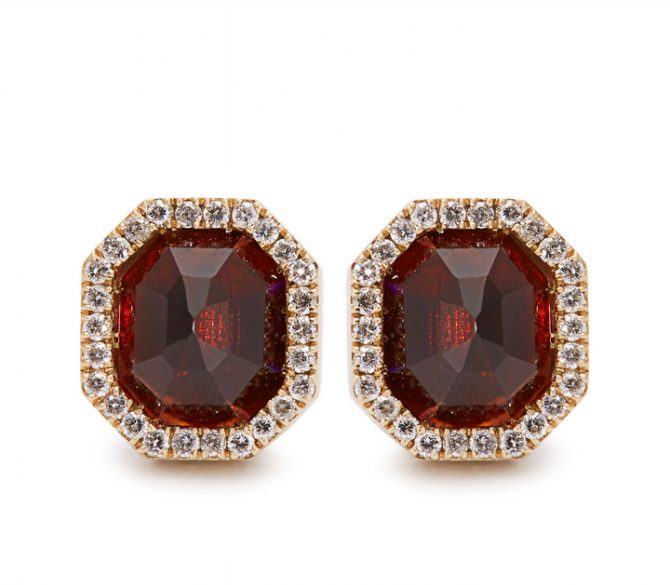
Photo Monique Péan
Today’s Treasure: Monique Péan garnet, diamond and white gold earrings
The Spiritual: Garnets represent goodwill, happiness, and purpose. It is also believed garnets bring peace, prosperity and health to a home.
The Physical: Garnet is thought to heal wounds, stimulate metabolism and purify blood. There is the notion that it’s almost an anti-depressant. It is has a pay it forward component. There is a belief that those who do good while wearing garnet will be the recipients of goodwill. In the past, garnet was worn by warriors and as a talisman of protection.
The Historical: The Egyptians believed garnets were a symbol of life. Nobility in ancient Rome wore garnets in signet rings. During the Victorian period garnets were at a peak of popularity and appeared in all kinds of jewels.
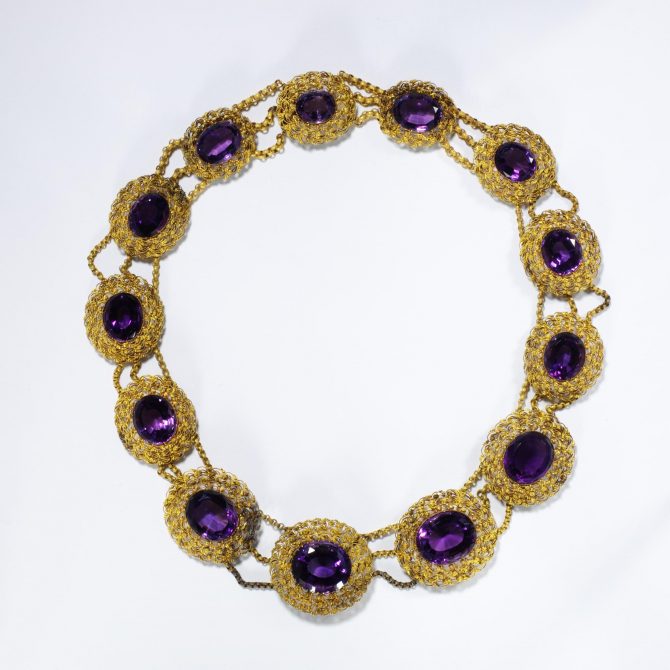
Amethyst and gold necklace made around 1820 Photo © Victoria and Albert Museum, London
FEBRUARY
Birthstone: Amethyst
What’s in a Name: The word for sober in ancient Greek, amethustos, oddly enough inspired the word amethyst. While it sounds like the wordsmiths might have been drinking when they came up with this one, the term was actually based on the belief that an amethyst could prevent the person wearing it from becoming drunk.
Some Places Where it’s Found: United States, Canada, Brazil and Zambia
True Colors: Ranging from deep purple to pastel pink, the variety of quartz often occurs in geodes or in the cavities of granitic rocks.
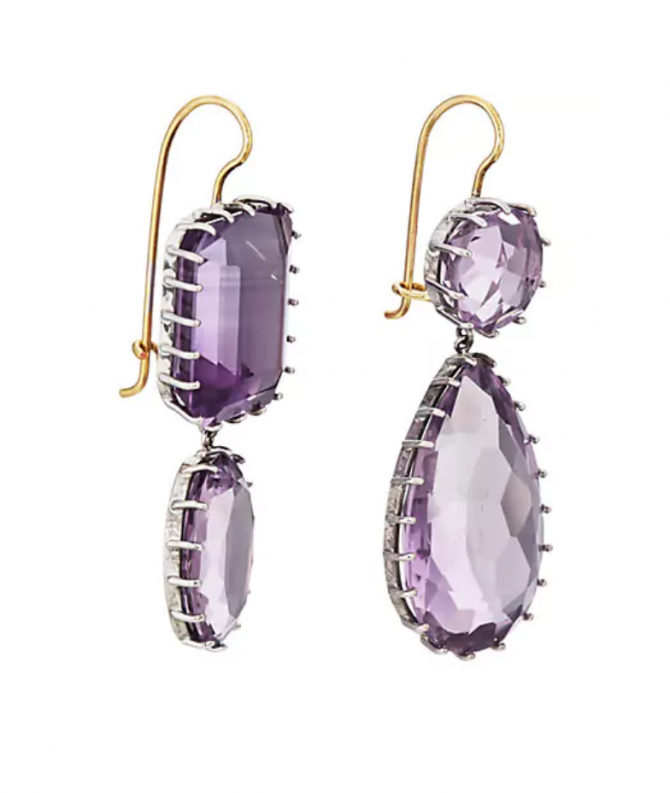
Photo Renee Lewis/Barneys
Today’s Treasure: Renee Lewis Mismatched Amethyst Earrings
The Spiritual: Amethysts are thought to enhance creativity, passion and harmony. Often used in meditation, the energy of an amethyst is believed to help stability, humility and relaxation.
The Physical: Natural hormone balancer is one of the properties amethysts are thought to have. Others include the ability to build the immune system, reduce bruising and pain.
The Historical: When amethysts were rare, they were as prized as diamonds. Monarchs used amethyst as a symbol of royalty. The gem was believed to promote prophecy among other things.
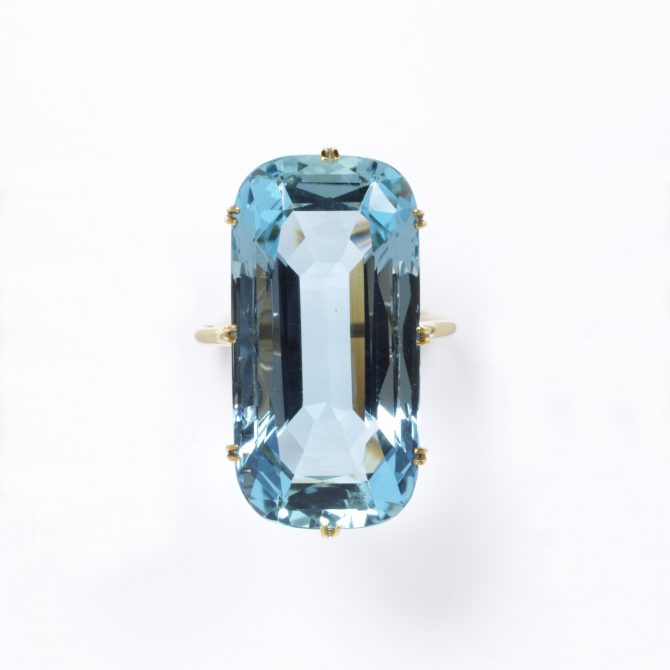
Eighteenth century aquamarine and gold ring Photo © Victoria and Albert Museum, London
MARCH
Birthstone: Aquamarine
What’s in a Name: The serenely colored aquamarine invokes the tranquility of the two Latin words that inspired its name: aqua for water and marina, for sea.
Some Places Where It’s Found: Brazil, Nigeria, Madagascar, Zambia, Pakistan, and Mozambique
True Colors: Aquamarines range in color from pale to deep blue with several greenish blue varieties.
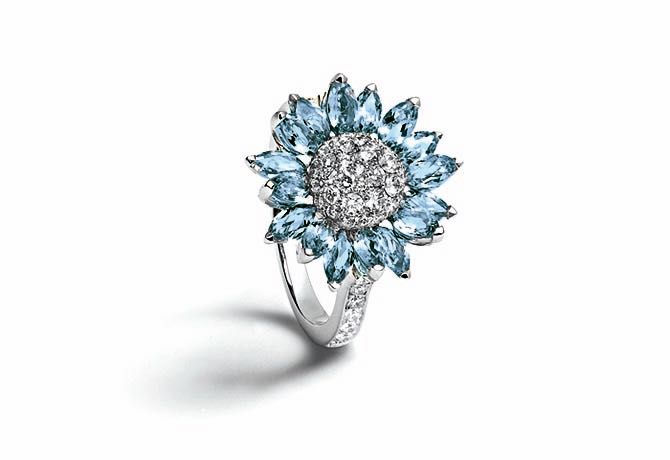
Photo Asprey
Today’s treasure: Asprey aquamarine, diamond and white gold Daisy Heritage ring
The Spiritual: The gem is used as an aid for meditation and spirituality. It is supposed to provide a sense of calm and tranquility. A stone of empowerment, it is believed to encourage honest and compassionate communication.
The Physical: Aquamarine is thought to heal sinus conditions, allergies and respiratory problems, teeth and gum issues, as well as tired eyes. It is known as a cooling gem.
The Historical: The Greeks and the Romans considered aquamarines the treasure of mermaids. Sailors believed they would safeguard a ship in a storm. It was also believed to protect soldiers going into battle.
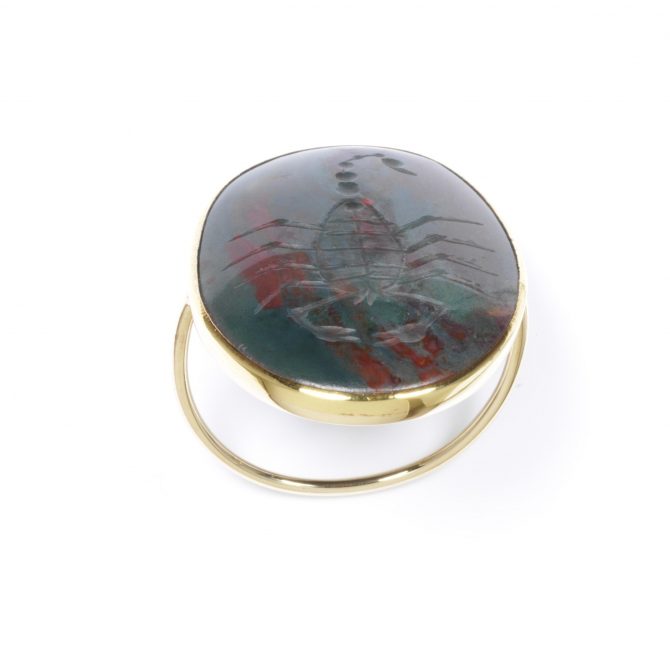
Eighteenth century bloodstone scorpion intaglio ring Photo © Victoria and Albert Museum, London
Traditional March Birthstone: Bloodstone
What’s in a Name: The red blood-like lines that run through the green stone inspired the name.
Some Places Where It’s Found: India, Brazil, and Australia
True Colors: A variety of jasper, the dark-green stone is flecked with vivid red spots of iron oxide.
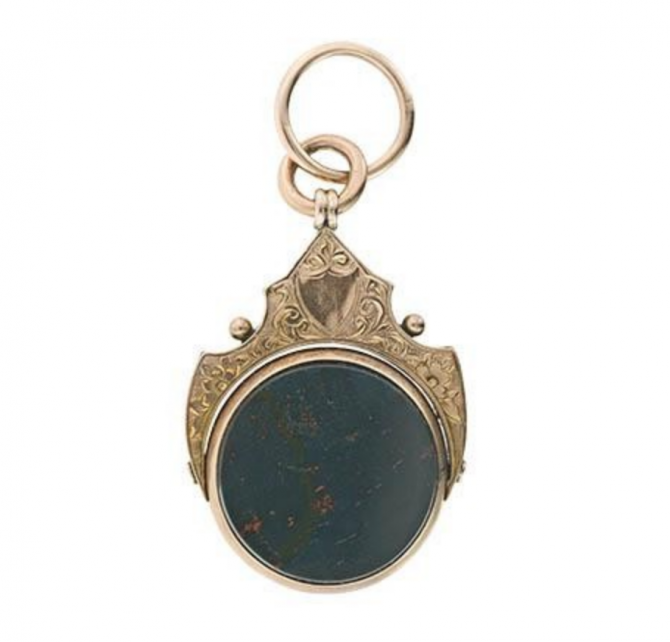
Photo Lang Antiques
Today’s Treasures: Not many contemporary designers use bloodstone in their work. If you are looking for the gem seek vintage pieces like this Victorian watch fob from Lang Antiques that could be worn as a pendant.
The Spiritual: Some believe Bloodstone helps with mental clarity, creativity or energy.
The Physical: Bloodstones are generally considered a healing stone, especially with blood disorders.
The Historical: Many ancient civilizations used the stone to assist in their divination and magically defeat their enemies. Crazy as it sounds, the ancient Egyptians claimed the stone had the power to make them invisible.
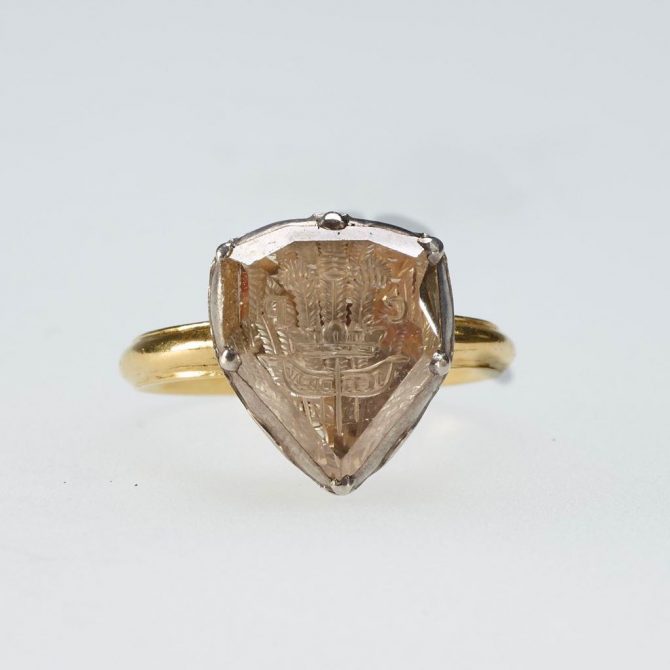
A large shield-shaped diamond carved with the Prince of Wales’s feathers and CP monogram for Charles I made around 1625. Photo © Royal Collection Trust
APRIL
Birthstone: Diamond
What’s in a Name: The Greek words adamas meaning unbreakable and diaphanus for transparent were merged together to form the term diamond.
Some Places Where It’s Found: Australia, Botswana, Canada, South Africa and Russia
True Colors: Most diamonds are transparent or white. The gem also comes in all colors of the rainbow. Any diamond other than a white diamond is called a fancy colored diamond.
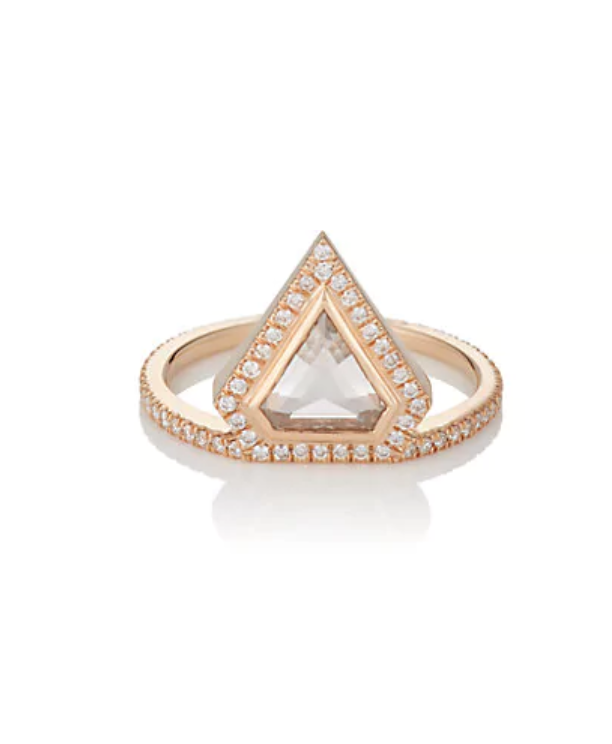
Photo Eva Fehren/Barneys
Today’s Treasure: Eva Fehren diamond and rose gold Kent ring
The Spiritual: Diamonds are believed to bring a sense of radiance, energy and light to the soul. The super hard stone is thought to provide strength and clarity in stressful situations.
The Physical: The gem is considered a support stone and a master healer to unify the mind and body. Diamonds are also thought to be beneficial in strengthening brain functions and cleansing the organs.
The Historical: Warriors in ancient Greece wore diamonds to make themselves invincible while the Romans regarded the stone as a symbol of innocence and purity. During the Renaissance, diamonds were first used as engagement rings.
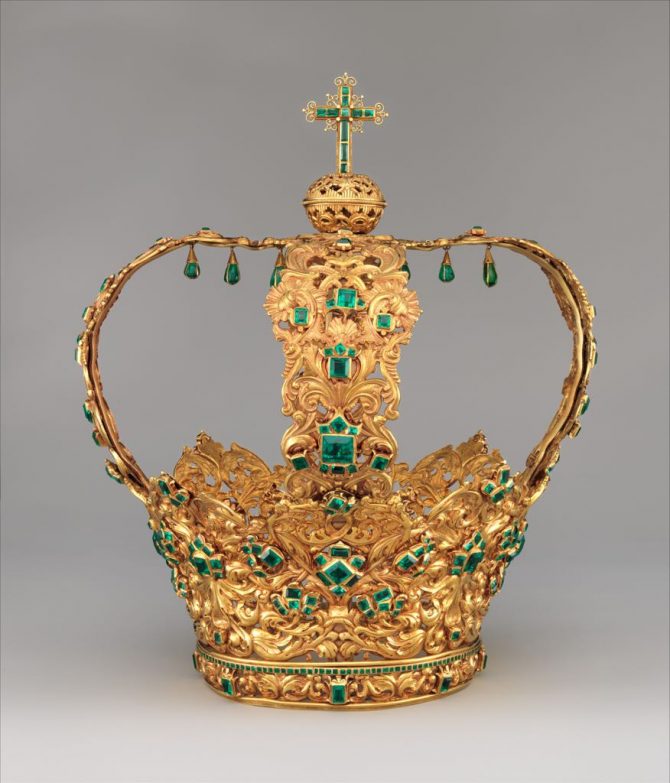
Emerald accented the gold Colombian Crown of the Andes. The crown was made around 1660 and the arches were added 100 years later. Photo The MET
MAY
Birthstone: Emerald
What’s in a Name: Unlike other gems, it is difficult to find the root of the word emerald in the Latin term for the gem smaragdus.
Some Places Where It’s Found: Colombia, Brazil, Afghanistan and Zambia
True Colors: Emerald ranges from yellow-green to blue-green with the finest being a pure green hue.
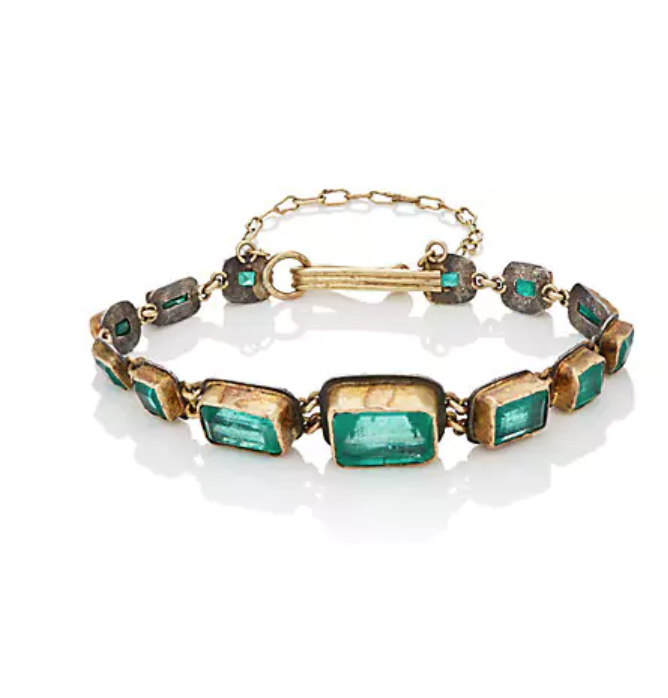
Photo Judy Geib/Barneys
Today’s Treasure: Judy Geib Colombian Emerald Bracelet
The Spiritual: Emerald is believed to have many mystical powers. It is said to transform negativity into positive energy, security, harmony and spirituality.
The Physical: Just looking at emeralds was once believed to cure stomach, skin and intestinal problems. The gem was also thought to be able to keep the wearer’s attitude serene.
The Historical: Emeralds were mined in Egypt as early as 330 BC. Cleopatra famously collected the stone. The Egyptians used emeralds in jewelry and in elaborate burials as a symbol of protection.
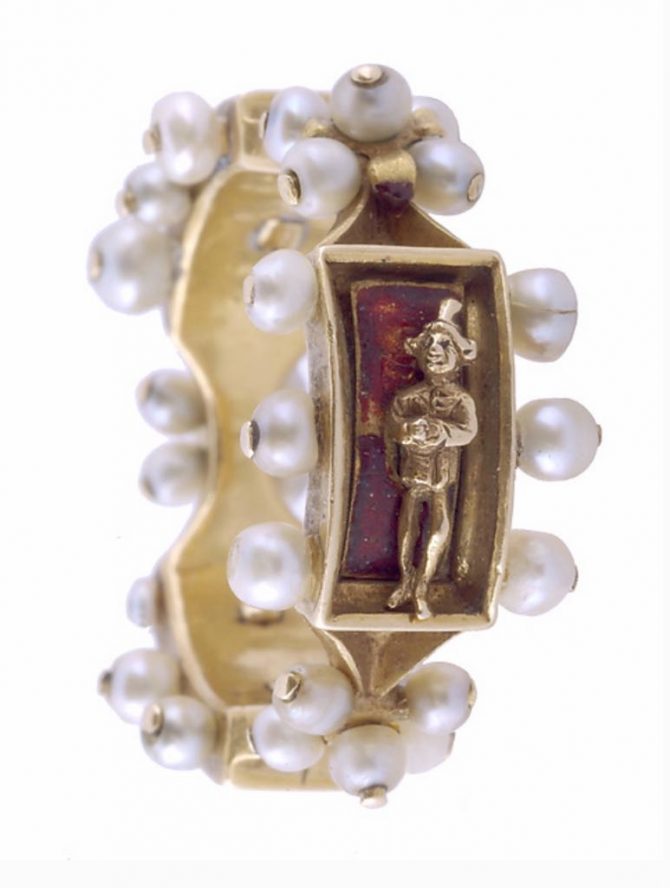
Mid-fifteenth century pearl, enamel and gold Renaissance ring from the Metropolitan Museum of Art Collection at the Cloisters Photo MET Museum
JUNE
Pearl and Moonstone
Birthstone: Pearl
What’s In A Name: The name pearl originates from the Latin word for leg, perna. It rather imaginatively is a reference to the leg-of-mutton shape of an open mollusk shell.
Some Places Where It’s Found: China, Australia, Philippines and Indonesia
True Colors: The only gem made by living creatures, pearls come in a range of colors from white to black Tahitian pearls and rare pink Conch pearls.
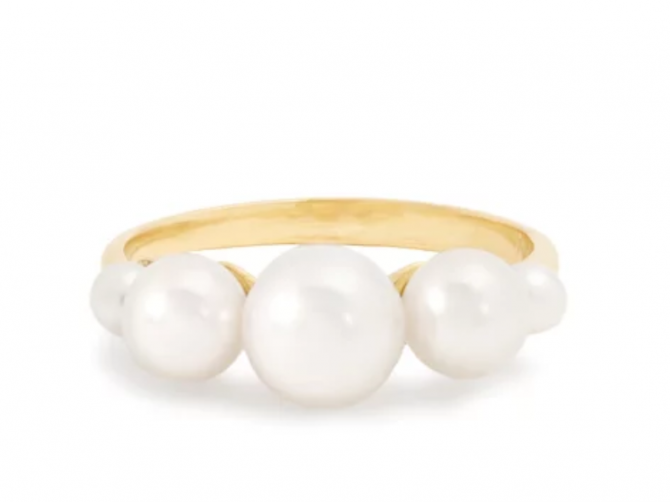
Irene Neuwirth pearl and gold ring Photo Irene Neuwirth/Matches
Today’s Treasure: Irene Neuwirth Pearl and Gold Ring
The Spiritual: Pearls are believed to create a sense of balance and provide emotional healing. The gem is also associated with faithfulness, loyalty, modesty and purity.
The Physical: Pearls have been used throughout history to help treat the digestive tract, maintain strong bones and brighten skin in the form of pearl powder.
The Historical: Ancient Greeks believed pearls were tears of the gods. Hindus thought pearls were tears of the moon. Tudor England became known as the Pearl Age, because the gem was so popular with nobility.
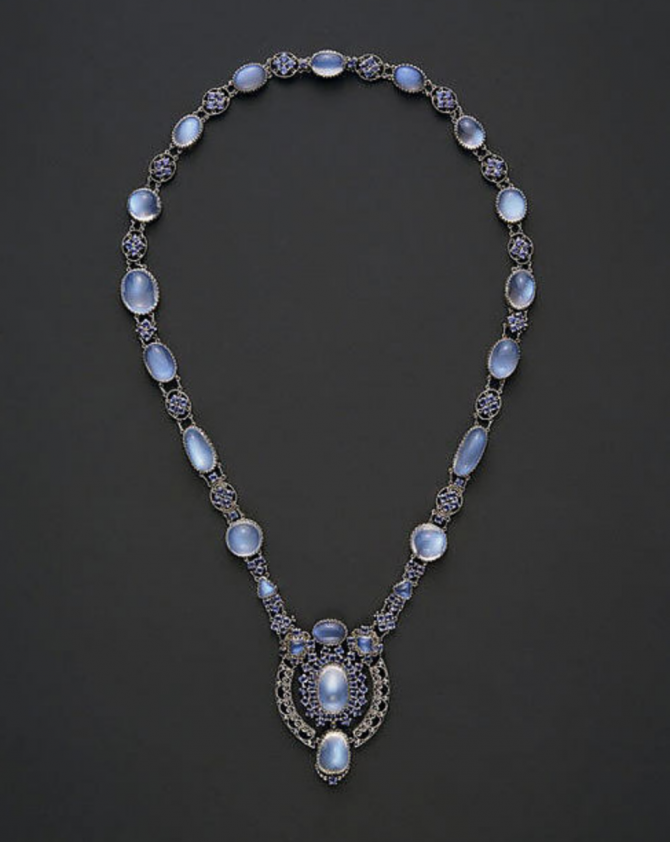
Moonstone, sapphire and platinum necklace designed by Louis Comfort Tiffany for Tiffany around 1910 Photo MET Museum
June Birthstone: Moonstone
What’s in a Name: The Roman historian Pliny named moonstones and poetically wrote that the gem’s shimmery appearance shifted with the phases of the moon.
Some Places Where it’s Found: Sri Lanka, India, Australia, Myanmar, Madagascar and the United States
True Colors: Composed of microscopic layers of feldspar that scatter light, thin layers of Moonstone produce a bluish sheen, while the thick layers look white.
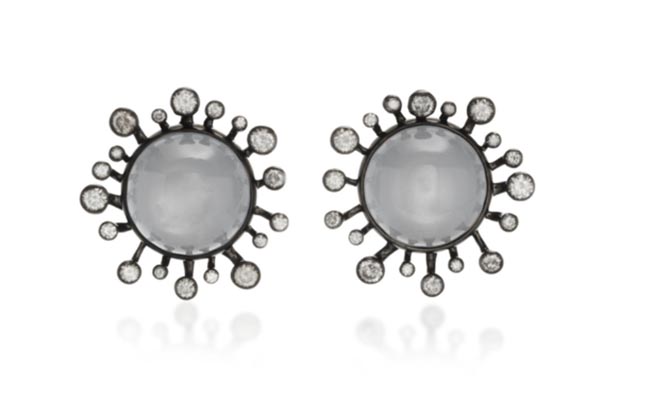
Photo Vram/Moda Operandi
Today’s Treasure: Vram Grey Moonstone and Diamond Earclips
The Spiritual: As its name implies, moonstone is closely associated with lunar mystery and magic. Its balancing energies can supposedly sync with the rhythms of nature, igniting passion between lovers.
The Physical: Moonstone’s are known as the Traveler’s Stone, because it’s believed to provide protection at night for people on a trip. Some credit the stone with helping to provide a good night’s sleep and beautiful dreams as well as treating insomnia and sleepwalking.
The Historical: The ancient Romans and the Greeks treasured the moonstone for it’s connection to their lunar gods. They believed the stone was formed from moonbeams.
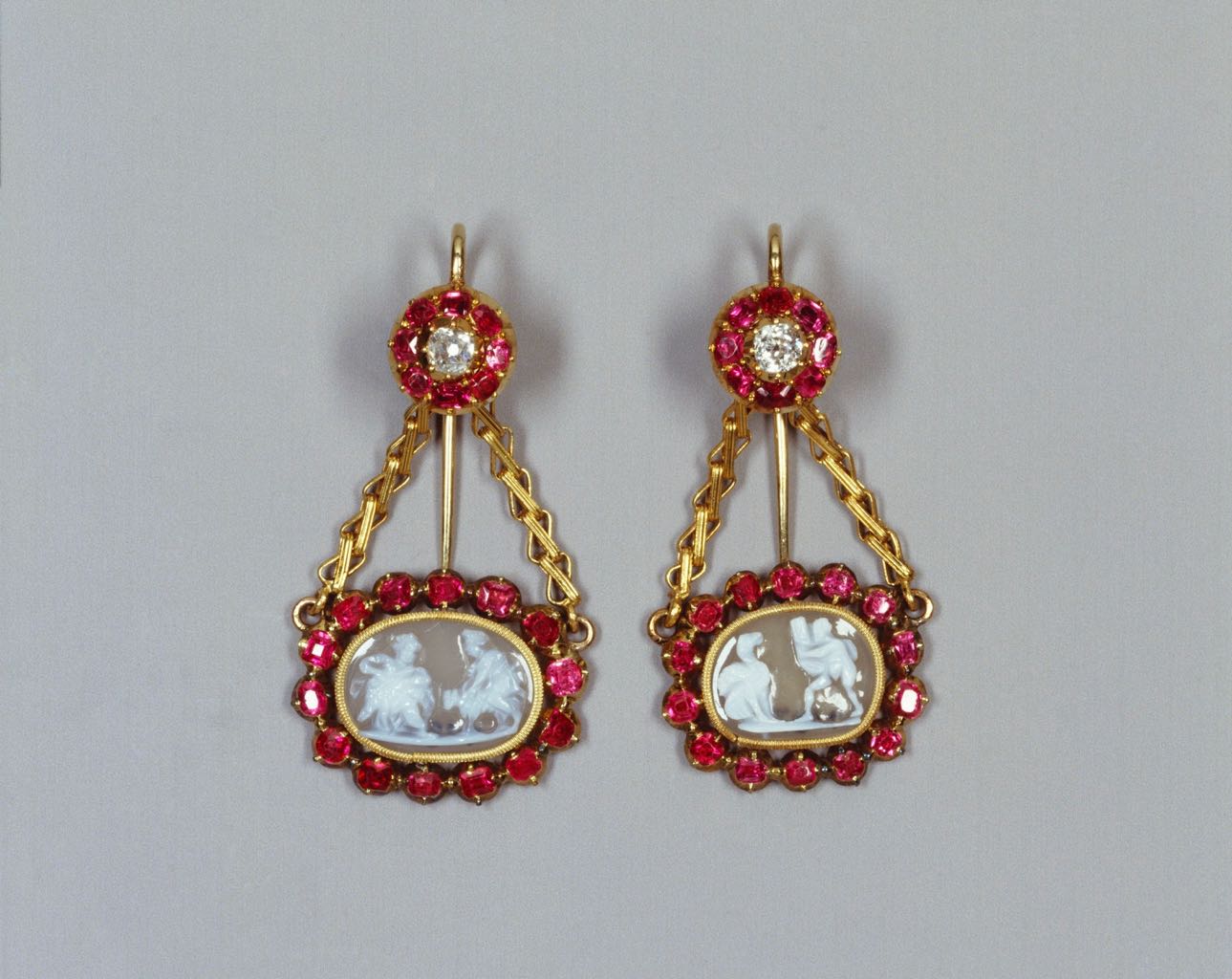
Burmese ruby and gold earring early-late 19th century earrings set with cameos made in the 16th or 17th century. Photo © Royal Collection Trust
JULY
Birthstone: Ruby
What’s in a Name: The name ruby comes from the Latin word for red, rubeus.
Some Places Where It’s Found: Burma, Vietnam, Thailand, India, Middle East, East Africa and the United States
True Colors: The rich red color of the ruby is caused by the element chromium, which also makes the gem glow from within. While it sounds awful, the best color of rubies is called “pigeon’s blood.”
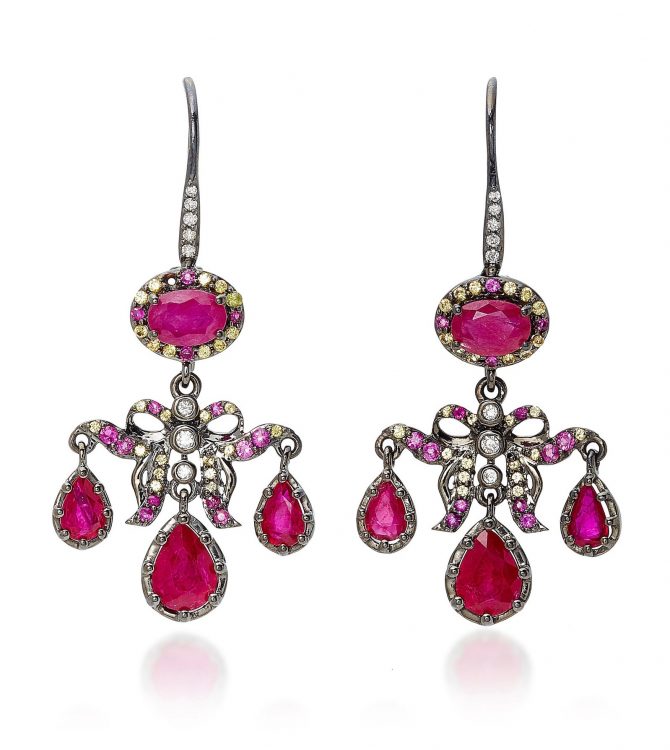
Photo HollyDyment/Moda Operandi
Today’s Treasure: Go Lightly Medora Girandole ruby, diamond and gem earrings.
The Spiritual: Rubies have been a symbol of passion, protection and prosperity since ancient times. The gem is believed to amplify energy, heighten awareness, promote courage and bring success in wealth, love and battle.
The Physical: Thought to energize and balance, stimulate the heart chakra and encourage a passions, the stone is used to detoxify the body and heal the heart and respiratory system.
The Historical: In ancient times, ruby was worn as an amulet to ward off the plague and diseases. It was also believed to be the most precious of gemstones during the time of the Judean Temple, for its passion and energy was said to bring love, success and good fortune.
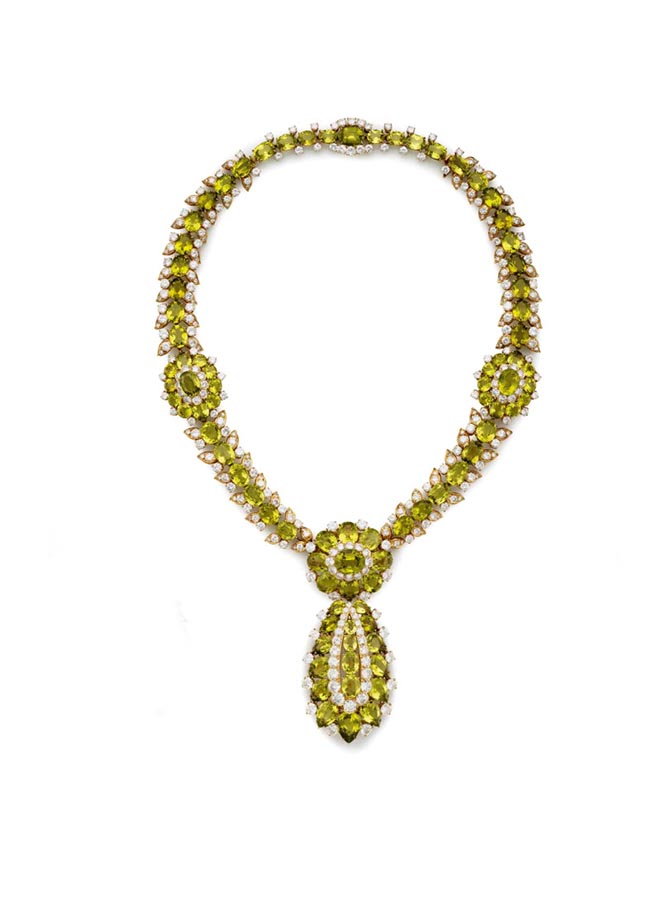
Peggy Rockefeller’s peridot and diamond suite made by Van Cleef & Arpels in the mid 1960s. Photo Christie’s
AUGUST
Peridot, Spinel and Sardonyx
Birthstone: Peridot
What’s in a Name: There is some debate about the origin of the term, but most believe it comes from the Greek word for giving plenty, peridona.
Where It’s Found: Arizona, China, Myanmar, Pakistan and Africa
True Colors: It is one of the only gemstones that forms in only one color green. The shades range from lime green to olive and brown, depending on how much iron is present.
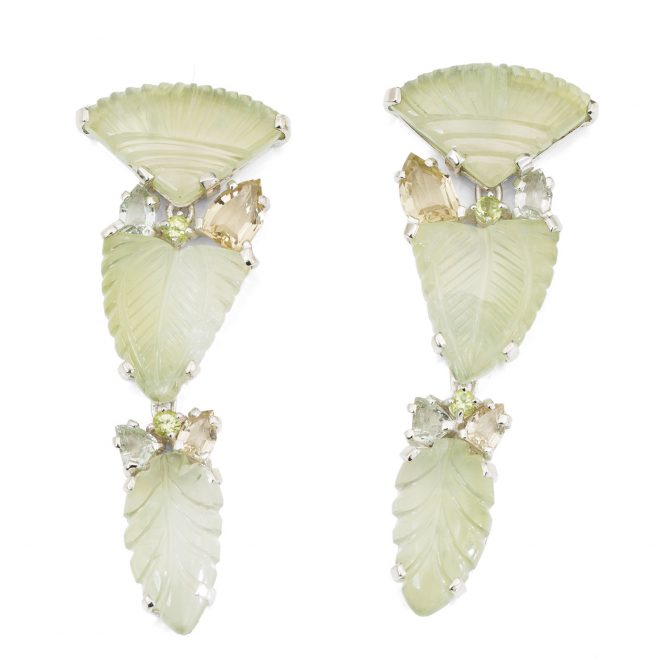
Photo Stephen Dweck
Today’s Treasure: Peridot earrings by Stephen Dweck
The Spiritual: Peridot is believed to stimulate psychological clarity and inspire a sense of happiness, truth and understanding. Believers think it empowers one to take responsibility and make decisions, resulting in prosperity and good fortune.
The Physical: The stone is supposed to support the digestive system. It was used as a talisman during childbirth. Its green energy helps with internal balance, peaceful sleep and releasing negative feelings.
The History: Ancient Egyptians called peridot the gem of the sun. They believed it protected its wearer from terrors of the night and harnessed the power of nature.
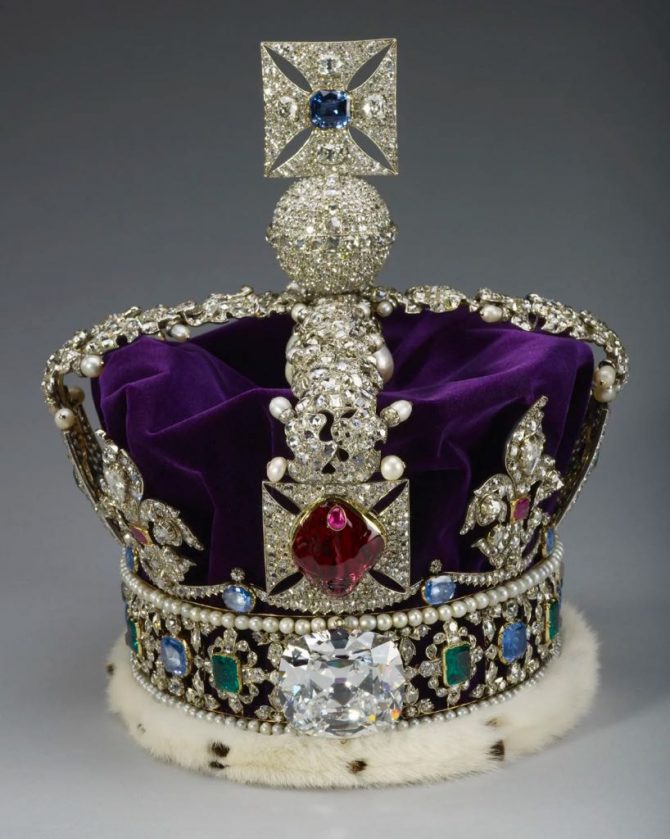
Imperial State Crown of England featuring the Black Prince Ruby at the front. The gem is in fact a spinel. Photo © Royal Collection Trust
August Birthstone: Spinel
What’s in a Name: The name spinel originates from the Latin word for form, spina, due to its pointed crystal shape in rough form or the Greek word spítha for spark in reference to its bright color.
Some Places Where It’s Found: Cambodia, Myanmar, Sri Lanka, Thailand, Afghanistan, and Australia
True Colors: The most common colors are red, pink, blue and black.
The Spiritual: Spinel is believed to bring high energy and prosperity.
The Physical: Spinel is used for astral travel, as it supposedly helps with gaining and cleansing the energies.
The Historical: Spinels were often mistaken for rubies. The most famous example of the confusion was the Black Prince Ruby in the Imperial State Crown of England. In the last 18th century gemologist figured out the difference between the similar looking gems, but the name has never been changed for the famous stone in British regalia.
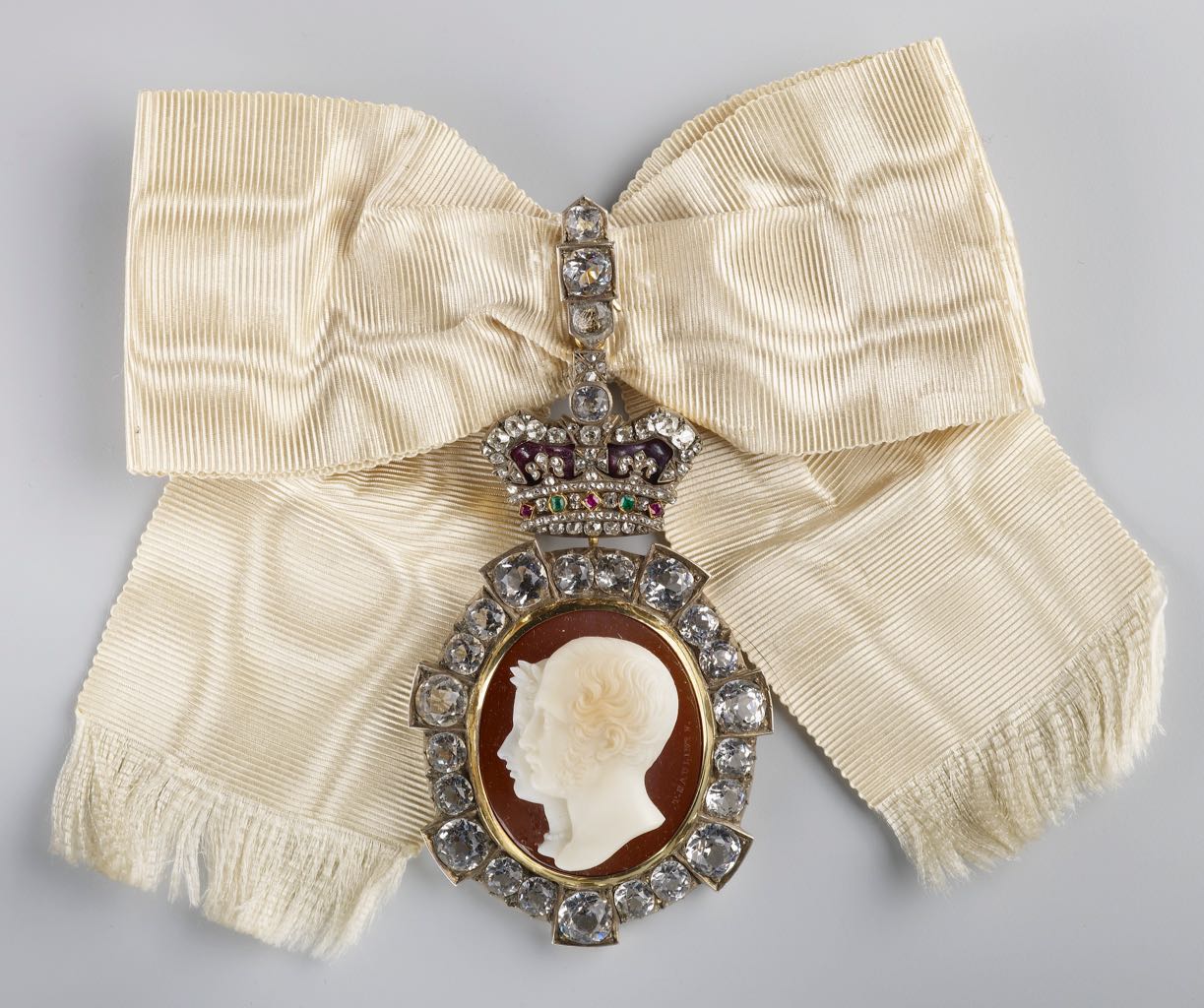
Badge of the Order of Victoria and Albert made around 1863 of a sardonyx cameo in a setting composed of gold, silver, enamel, diamond, rubies, emeralds, white pastes. Photo © Royal Collection Trust
Traditional August Birthstone: Sardonyx
What’s in a Name: The name is a combination of two words. Sard is a reference to the ancient Persian city, Sardis, where the red stone was found. Onyx comes from the Greek word for nail or claw.
Some Places Where It’s Found: India, Brazil, Germany, Czechoslovakia, Madagascar, Uruguay and the United States
True Colors: The presence of iron oxide can affect the stones color, from yellowish to reddish with zebra-stripe inclusions of multiple layers of white bands.
The Spiritual: Used as a stone of strength and protection since ancient times, sardonyx is associated with courage and happiness.
The Physical: Sardonyx is believed to release anxiety, depression, and strengthen your immune system.
The Historical: In ancient Greece and Rome, soldiers wore engraved sardonyx talismans to battle, believing the stone would grant them courage, victory and protection. The stone was also used during the Renaissance, as an aid to clear thinking and communication. In jewelry the gem was mainly used in cameos.
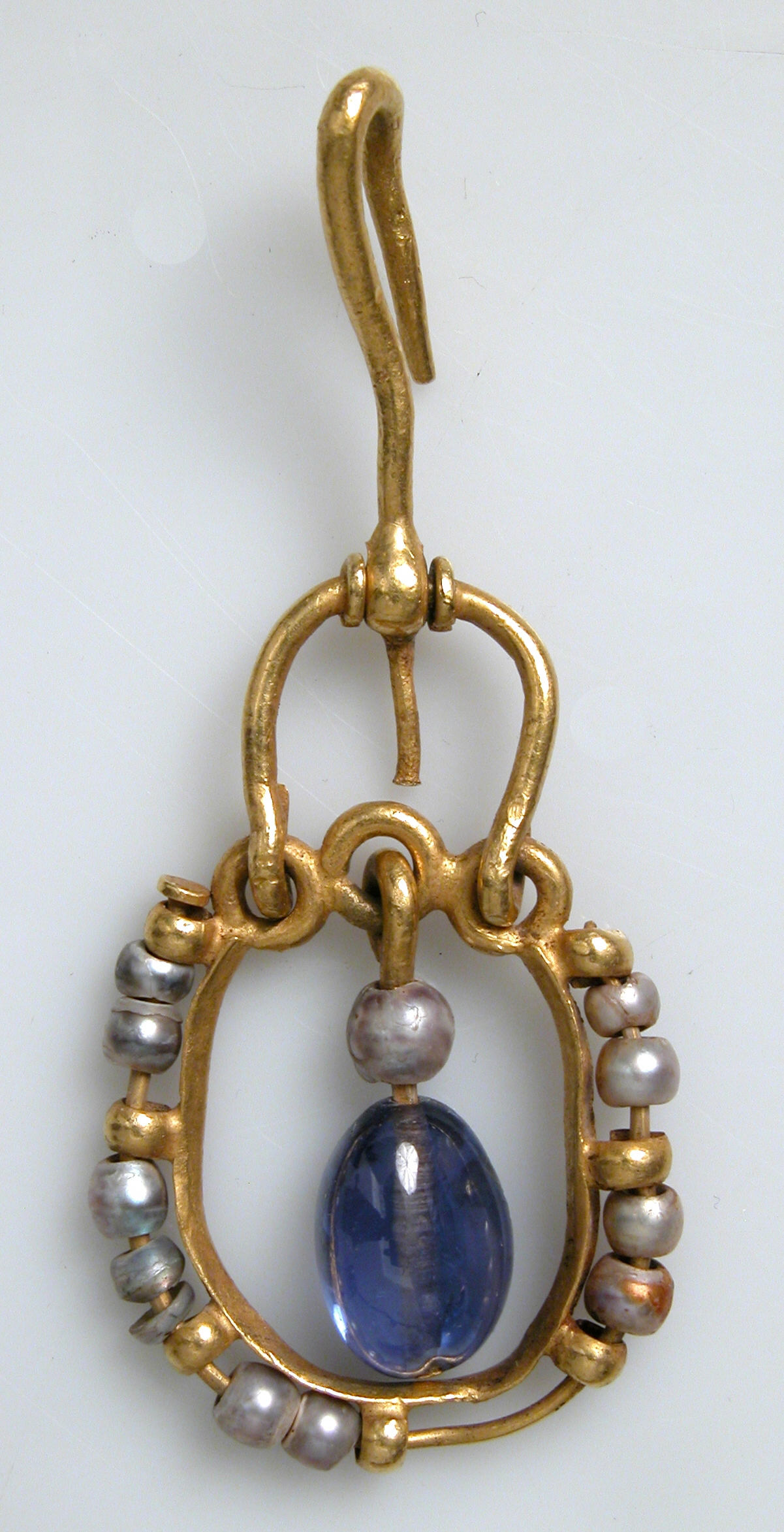
Byzantine sapphire, pearl and gold earring made during the 6th to 7th century. Photo MET Museum
SEPTEMBER
Birthstone: Sapphire
What’s in a Name: The name sapphire comes from the Latin sapphirus and Greek sappheiros. Both mean blue stone.
Where It’s Found: Kashmir, Burma, Sri Lanka, Thailand, Vietnam and India among other places.
True Colors: Although sapphire is generally understood to mean a blue, the gem comes in every color of the rainbow except red. When the sapphire mineral corundum is red, it is a ruby.
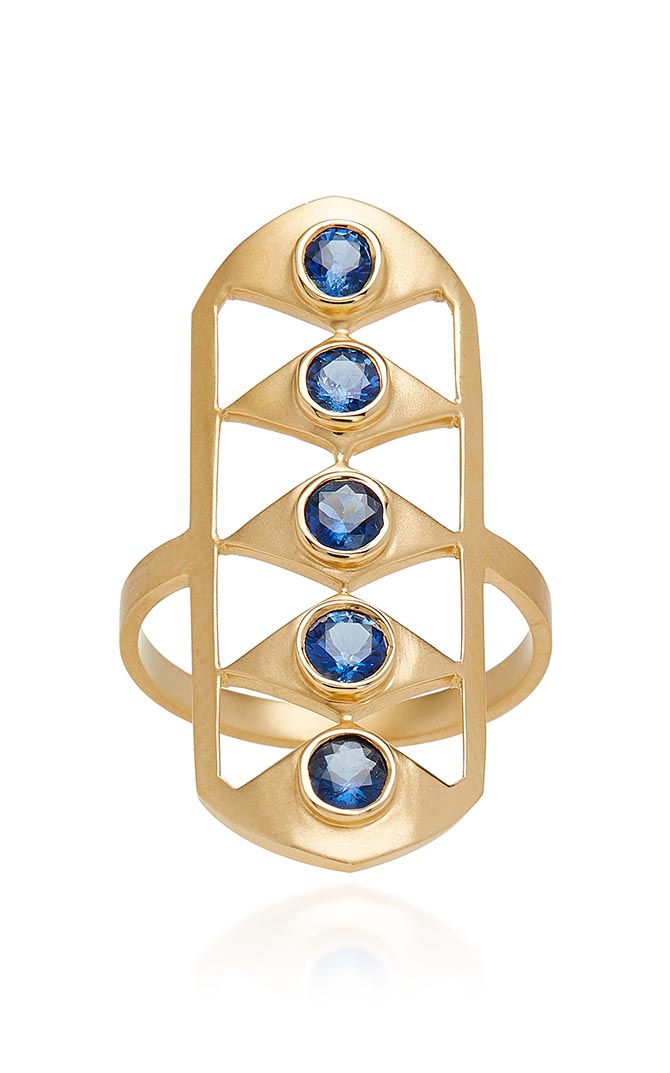
Photo Doryn Wallach/Moda Operandi
Today’s Treasure: Doryn Wallach blue sapphire and gold Gladiator ring
The Spiritual: Sapphires are a symbol of loyalty, nobility, sincerity and integrity. They are associated with focusing the mind, maintaining self-discipline and channeling higher powers.
The Physical: Blue sapphires are believed to be a cure-all that do just about everything including help insomniacs sleep.
The Historical: Greeks wore sapphire for guidance when seeking answers from the oracle, while Buddhists believed it brought spiritual enlightenment, and Hindus used it during worship. Sapphires were called hyakinthoi (hyacinths) in the sixth century when they were a popular gem in Byzantine jewelry.
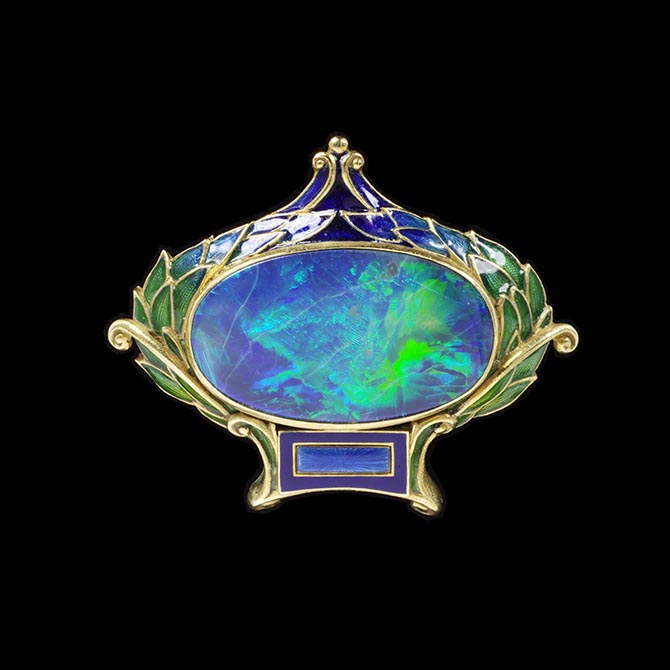
Marcus & Co. Opal, enamel and gold brooch made around 1900. Photo © Victoria and Albert Museum, London
OCTOBER
Opal and Tourmaline
Birthstone: Opal
What’s in a Name: The name opal originates from the Greek word opallios, which meant to see a change in color.
Some Places Where It’s Found: Australia, Brazil, Honduras, Ethiopia, and Czech Republic
True Colors: Microscopic silica spheres that diffract light to display various colors of the rainbow create a kaleidoscope of one-of-a-kind color combination, also called Precious Opals.
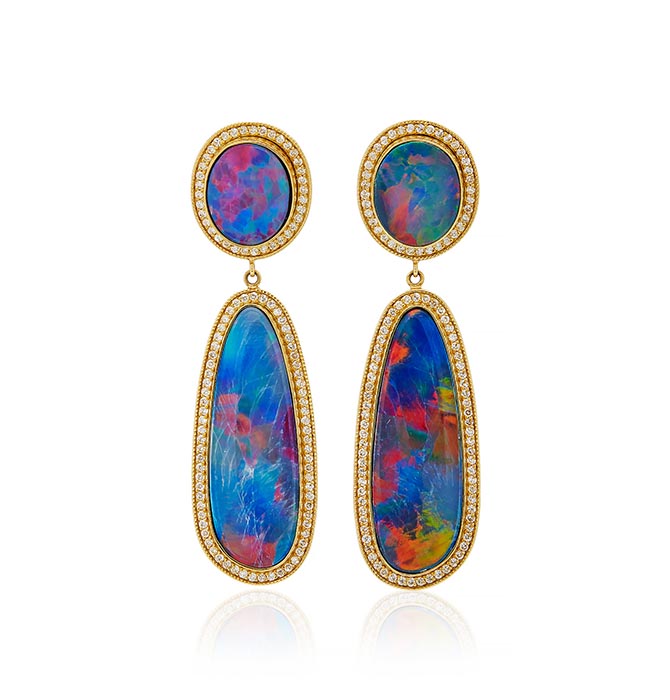
Photo Andrea Fohrman/Moda Operandi
Today’s Treasure: Andrea Fohrman Kat Australian Opal, Diamond and Gold Earrings
The Spiritual: As a stone of light, opal is believed to be the ideal gem to attract positive energies and center the mind for prayer and meditation.
The Physical: A supportive stone, dedicated to healing and emotionally strengthening, it’s thought to have properties to purify the blood, stimulate memory and balance hormones.
The Historical: According to Arabic legend, opals fell from the sky in bolts of lightning. It became associated with bad luck after a character wearing the gem in a popular novel by Sir Walter Scott ran into some trouble.
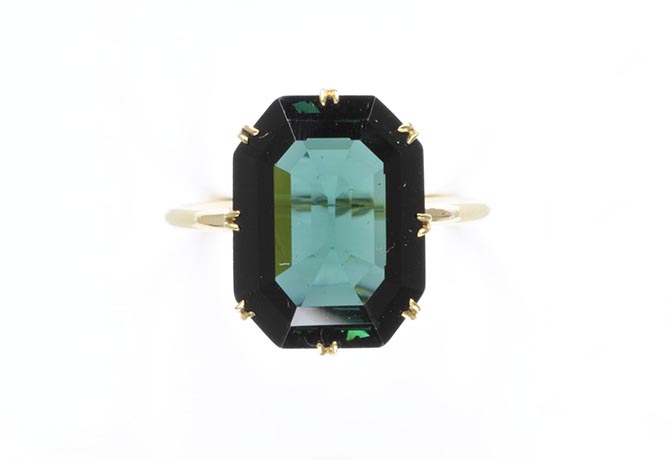
Blue green tourmaline and gold 19th century ring. Photo © Victoria and Albert Museum, London
October Birthstone: Tourmaline
What’s in a Name: The name tourmaline comes from the Sinhalese words tura mali, which mean stone of mixed colors.
Some Places Where It’s Found: Brazil, Sri Lanka, Nigeria, Mozambique, Madagascar, Afghanistan, Pakistan and the United States
True Colors: Tourmalines come in a vast array of colors ranging from black to bicolor pink and green, gems aptly named watermelon tourmaline. The most well-known tourmalines are probably the green variety.
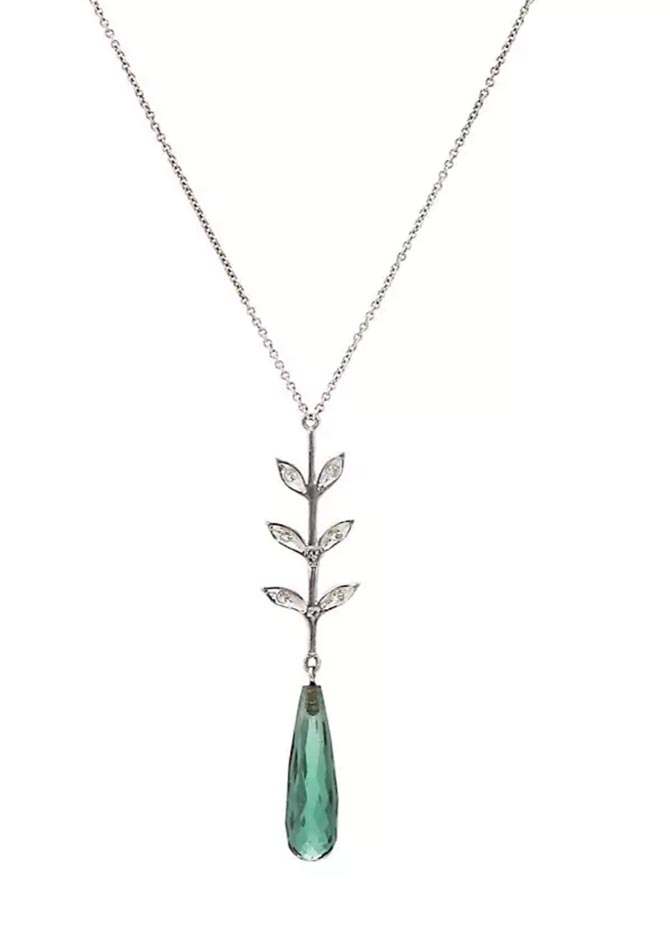
Photo Cathy Waterman/Barneys
Today’s Treasure: Cathy Waterman green tourmaline, diamond and platinum Wheat-Stem pendant necklace
The Spiritual: Tourmaline is believed to imbue a positive attitude, good luck and happiness.
The Physical: The stone is thought to aid in cleaning the organs, as it aids the metabolism and in hormone production.
The Historical: Tourmaline has been treasured in China for centuries as part of their rituals and ceremonies. Ancient magicians used black tourmaline as a form of protection against negative energy and evil forces.
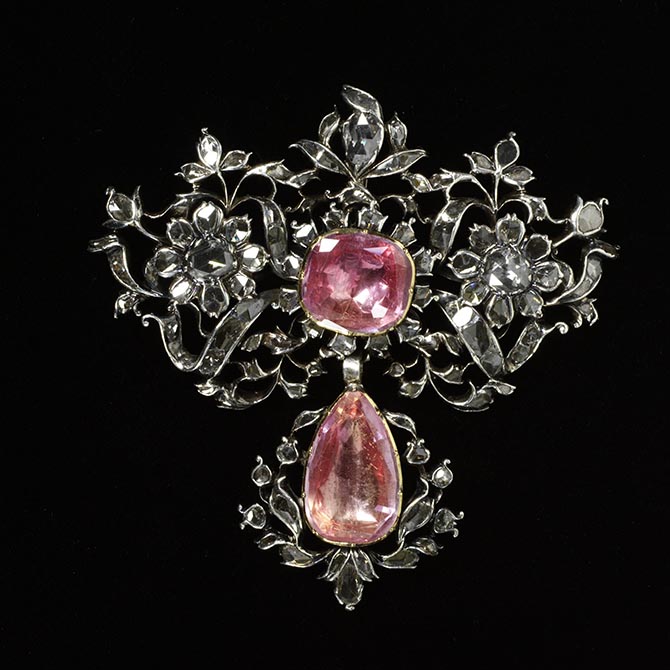
Pink Topaz, rose-cut diamond and silver pendant made in Portugal around 1750. Photo © Victoria and Albert Museum, London
NOVEMBER
Topaz and Citrine
Birthstone: Topaz
What’s in a Name: The name topaz derives from Topazios, the ancient Greek name for St. John’s Island in the Red Sea.
Some Places Where it’s Found: Brazil, Pakistan, India, Sri Lanka, Russia, Nigeria, Germany, and the United States
True Colors: Pure topaz is colorless. Impurities tint the stone to a variety of colors like blue, pink, yellow and brown. The most desirable type is the rich orange of Imperial Topaz.
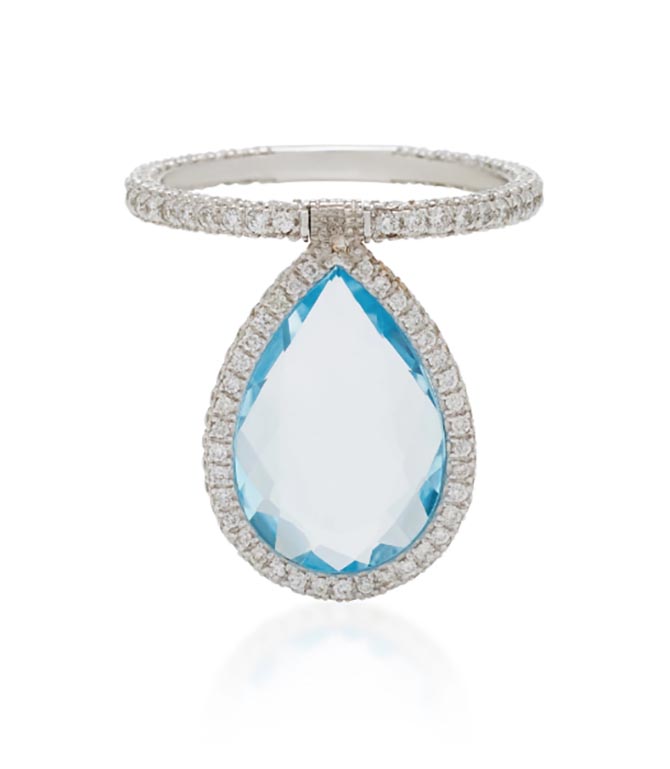
Photo Nina Runsdorf/Moda Operandi
Today’s Treasure: Nina Runsdorf Large Blue Topaz and 18K White Gold Flip Ring
The Spiritual: Topaz is believed to strengthen faith and trust.
The Physical: Yellow topaz is believed to be an anti depressant and improving brain function. Blue topaz are considered a soothing stone that clears the mind.
The Historical: To the ancient Egyptians, topaz symbolized Ra, the sun god. Greeks and Romans prized it for its ability to provide strength and prevent injury. The Hindus believed topaz would protect their homes from fire, and when worn above the heart, would assure long life, beauty and intelligence.
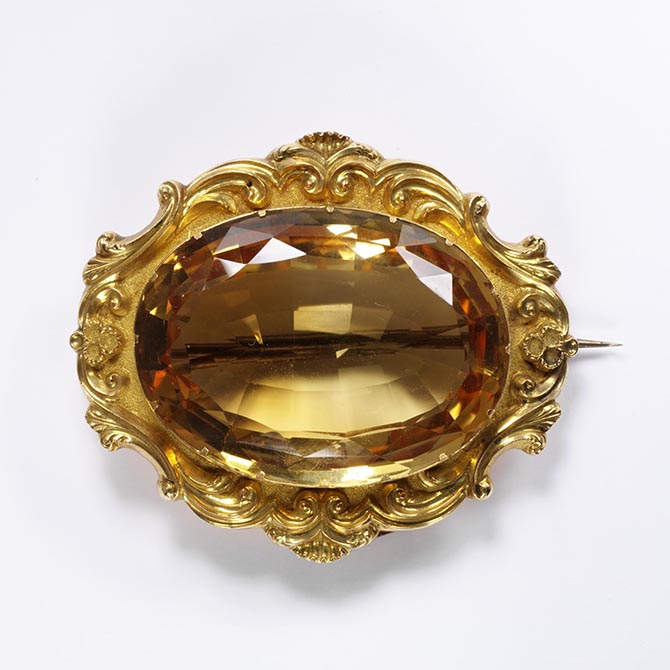
Citrine and gold brooch made in the mid-19th century. Photo © Victoria and Albert Museum, London
November Birthstone: Citrine
What’s in a Name: The name comes from the French word citron, meaning lemon.
Some Places Where It’s Found: Africa, Brazil, France, Madagascar, South Africa and the United States
True Colors: A variety of quartz, citrine ranges in colors from the most common yellow to red-brown.
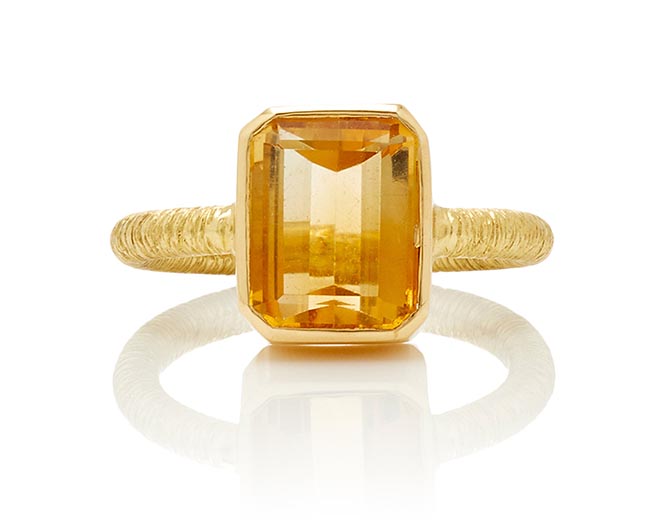
Photo Brent Neale/Moda Operandi
Today’s treasure: Brent Neale citrine and gold ring
The Spiritual: Believed to be powerful cleanser and regenerator, the gem supposedly inspires self-improvement.
The Physical: Citrine is thought to provide a boost to the circulatory system.
The Historical: Citrines can be found in jewels dating back to ancient Greece. It was a very popular gem in jewels from the 19th century through the 1940s.
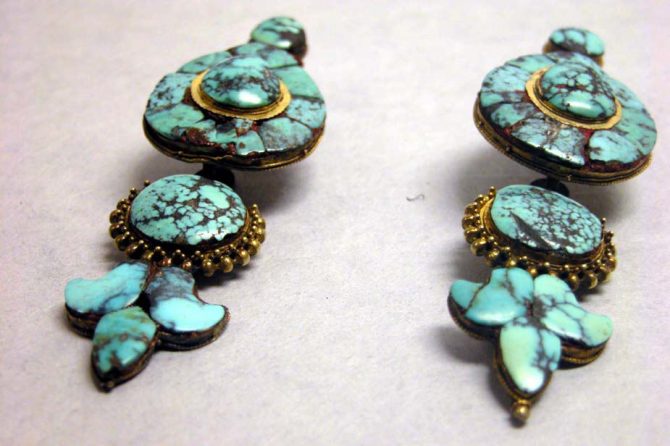
Turquoise earrings made in Tibet sometime during the 17th to 19th centuries. Photo MET Museum
DECEMBER
Turquoise and Tanzanite
Month: December
Birthstone: Turquoise
What’s in a Name: The word turquoise comes from the French tourques for Turkish stone. Traders from Turkey introduced the Persian blue stone to Europe via the Silk Road in the 13th century.
Some Places Where It’s Found: Iran and the United States
True Colors: Turquoise ranges in color from powdery blue to greenish robin’s egg blue.
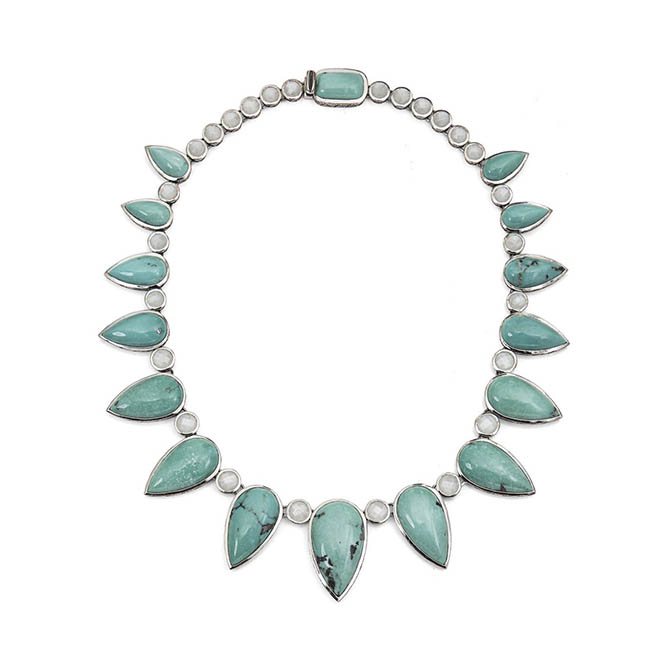
Photo Stephen Dweck
Today’s Treasure: Stephen Dweck Natural Turquoise and White Moonstone Fan Necklace
The Spiritual: Turquoise is believed to heal and cleanse the body. It is thought to aid in understanding, enhance trust, kindness, and the recognition of beauty.
The Physical: Turquoise is a strengthening stone, good for exhaustion, depression or panic attacks.
The Historical: Cultures around the world have admired the distinct color of turquoise since ancient times. Egyptians treasured its protective power and set it in necklaces, Persians set the stone into their daggers and war necklace and Native Americans used it in sacred ceremonies.
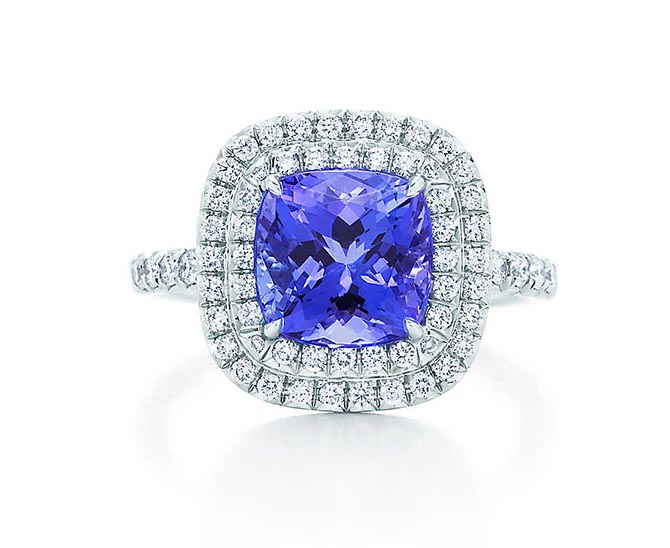
Tiffany Soleste Tanzanite, diamond and platinum ring. Photo Tiffany
Birthstone: Tanzanite
What’s in a Name: The name for tanzanite comes from Tanzania, the place where it was discovered in 1967.
Where It’s Found: Tanzania in East Africa is the only place the gem has ever been found.
True Colors: It’s unique intense violet-blue is often achieved by heat treating to remove any natural impurities.
The Spiritual: The gemstone is believed to open up an awareness between how one lives and one could live more consciously. It is thought to help people recognize their strengths.
The Physical: Tanzanite is thought to inspire creativity.
The Historical: In Tanzania, it is customary for women to wear tanzanite beads while giving birth to ensure a healthy baby. Tiffany popularized the gem after using it in jewelry
Related Stories:
9 Gems You’ve Probably Never Heard Of
The Most Expensive Earrings in the World
Get a gem in your mailbox SIGN UP FOR THE ADVENTURINE NEWSLETTER
